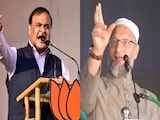- President Trump's 90-day pause on reciprocal tariffs ends on July 9, with August 1 as a possible new deadline
- Few trade deals have been reached; agreements with the UK and Vietnam are tentative and lack detail
- Major negotiations with China, Mexico, Canada, and the EU remain unresolved and complex
In late April, shortly after President Trump's announcement of sweeping reciprocal tariffs sent markets reeling, the White House announced a 90-day pause on when those tariffs would go into effect.
That pause is about to end and while the Trump administration has announced a few tentative trade agreements - including one with the UK and another with Vietnam - they're nowhere near 90.
On today's Big Take podcast, Bloomberg's Brendan Murray and host David Gura discuss what the White House has accomplished, what it hasn't and where the trade war goes from here.
Here is a lightly edited transcript of the conversation:
David Gura: President Trump's trade war began in earnest in April, when he announced a raft of new tariffs.
Donald Trump: Our country and its taxpayers have been ripped off for more than 50 years, but it is not going to happen anymore.
Gura: Trump said he'd impose "reciprocal" tariffs - across-the-board levies on dozens of trading partners, including the European Union, Japan and South Korea and the United Kingdom.
Trump: "Reciprocal." That means they do it to us and we do it to them. Very simple. Can't get any simpler than that.
Gura: But after that announcement sparked market turbulence, the president changed course. He announced a 90-day pause on the implementation of those tariffs. On Fox Business, Trump's trade advisor, Peter Navarro, presented it as an opportunity for those trading partners to negotiate:
Peter Navarro: So, we're going to run 90 deals in 90 days- is possible. The boss is going to be the chief negotiator. Nothing is done without him looking very carefully at it.
Gura: Well, that pause is about to end on Wednesday. And while the Trump administration has announced a few tentative trade agreements, including one with the UK and another with Vietnam, they're nowhere near 90. So, over the weekend, on CNN's State of the Union, Treasury Secretary Scott Bessent laid out what's likely to happen next.
Scott Bessent: President Trump is going to be sending letters to some of our trading partners saying that if you don't move things along, then on August 1, you will boomerang back to your April 2 tariff level.
Gura: Brendan Murray oversees Bloomberg's trade coverage, and he says it looks like August 1 is the new July 9:
Brendan Murray: You know, 90 days was always an arbitrary sort of number that they just pulled out of the air.
Gura: The move is in keeping with how the White House has waged this trade war from the very beginning: Moving deadlines, putting tariffs in place, then taking them off and adjusting tariff levels with no explanation.
Murray: It feels like it's a little bit of Groundhog Day every day on the trade beat to some extent- is that we're gonna go through this all over again.
Gura: I'm David Gura, and this is The Big Take, from Bloomberg News. Today on the show, as President Trump's 90-day pause on his sweeping reciprocal tariffs comes to an end, what comes next? What the White House has accomplished, what it hasn't, and where the trade war goes from here.
Gura: The problem with counting how many trade deals the White House has done is it depends on how you define the word "deal." Bloomberg's Brendan Murray says the Trump administration reached an agreement with the United Kingdom, and President Trump announced a trade deal with Vietnam on social media, where, on Monday afternoon, the president also said he'd impose 25% tariffs on imports from Japan and South Korea and a 30% tariff on imports from South Africa. But as the end of this 90-day pause nears, Brendan says we haven't seen the fine print, and we don't know the status of other negotiations.
Gura: From your vantage point, how much has been accomplished here over the course of these 80-plus days?
Murray: Well, it's hard to say how far along the talks are with all of these other countries, but the main ones, China, Mexico, Canada - those are the three biggest US trading partners - those are all still in flux, and we don't know where those are headed. The president has said that, you know, he is going to stick to his auto tariffs and his steel tariffs and aluminum tariffs, and those are really important to Canada and Mexico, and they're going to try to negotiate those away. Now the other big deal, that really means more than any of those three, is one with the European Union. We think of Canada, China, Mexico as the biggest US trading partners, but the European Union as a block is really the biggest and the most integrated when it comes to goods trade, services trade and investment that goes back and forth between the two economies.
Gura: How hard and fast is this deadline on Wednesday? We heard from the president last week indicating that he didn't intend to blow past it or offer any kind of extension. What's the latest from him and his administration on the hard and fastness of that July 9 deadline?
Murray: Well as we're getting closer to that, they're inserting some wiggle room in there. Now they the thinking is, and, and what we've heard from some of the folks in the administration is that they've got a bottleneck of these deals that are just on the very edge of being resolved and being signed but they can't get 'em all over the line before, July 9, the original deadline. So it seems like August 1st is becoming the new deadline. None of this is a surprise to anybody who watches trade negotiations. These are complicated deals that have to be done back and forth between capitals over different time zones, and they just take a long time and they involve complicated things that countries just aren't going to give up overnight. And so, we've seen the 90 deals in 90 days come down to maybe a half dozen deals in probably a hundred letters.
Gura: Broad strokes, what do you expect to play out between now and July 9th or August 1, what are we likely to get from the White House? Sort of how should we think about or read what's gonna be in, in letters or, or deal announcements to get a sense of, of what's actually in these deals and agreements.
Murray: I think what we're gonna see, if they release the deals at all, we're going to see how basic they are, how broad they are, how lacking in concrete commitments. There's probably going to be some agreements to purchase a certain amount of US exports of agriculture goods, for instance, or Boeing airplanes. These are more commercial arrangements than they are trade, trade deals. But every country is now gonna be faced with a 10% tariff on their exports to the US, at least. That's going to be across the board. There doesn't seem to be any negotiating that away. So, in effect, president Trump is raising this tariff wall around the US economy, over which countries will have to just deal with, or there'll be retaliation.
Gura: Brendan, when you look at the negotiations between the US and these major trading partners, how much are the points of contention the same in all of those talks?
Murray: I think from the US' perspective, there are several issues that bother them. Among the biggest, and Trump has been pretty vocal about how he doesn't like that you can't buy Ford pickup trucks in Tokyo, or you don't see Chevys driving around Berlin. So, cars are one of the sort of regular sticking points with President Trump. He also is trying to crack down on the proliferation of Chinese products everywhere. And that could be everything from raw materials like steel to things like technological components that turn up in a lot of consumer items that we see. The Trump administration takes real issue with agriculture barriers to other countries' markets. India has very high protections around its agriculture industry where there's a big constituency of the Modi government that are subsistence farmers, and they would be, you know, economically devastated if the agriculture market of India were opened to the global trading system. So, those are barriers that are unlikely to go down anytime soon or in any way that's significant. And then, then there are a whole host of other issues that fall under this category of non-tariff barriers. And these are things like the tax system in the European Union or the way businesses are regulated in a country like South Korea.
Gura: Brendan, over the weekend, President Trump said he would charge an additional 10% tariff on any country aligning themselves with the anti-American policy of the BRICS nations' - this is a group led by Brazil, Russia, India and China. They were meeting over the weekend. What does that say just about what's motivating this trade war? What's motivating the levies that the president is putting in place?
Murray: I think it just illustrates how broadly the president thinks he can use tariffs to influence not just the trading relationships the US has with another country but geo-economic forces that are happening around him. Ironically, the BRICS organisation is growing. And it's growing because of the vacuum of the- what they perceive as the vacuum of the leadership of that the US has had over the years to steering the global economy, steering the global order in a certain direction. So, the BRICS now see themselves as a source of stability in the world, the ones you can trust, the ones you can count on, versus President Trump who seems to be filling the role of the sort of chief disruptor of the global economy.
Gura:The US Court of International Trade blocked many of the tariffs that President Trump had threatened or imposed on other countries. I asked Brendan how that decision, which the administration has appealed, has affected the White House's negotiations.
Murray: I think what it's done is slowed a lot of them down. Countries would be looking at that going, that's our get out of tariff free card. And they would be looking at the date of that next court hearing going, if we can just hold out that long, then perhaps the laws of the United States will strike down his authority to use those tariffs and we'll be in a completely different world.
Gura: In the meantime, the Trump administration is leaning more heavily on tariffs not on countries, but on specific sectors.
Murray: Those sectoral tariffs can be used very broadly. For example, the steel aluminum tariffs. For example, the steel and aluminum tariffs that he rolled out a few months ago were recently expanded to include appliances, washing machines - the kinds of things that everyday Americans go to Home Depot and buy because they contain steel and aluminum. So, you can use these sectoral tariffs very broadly. You can hit a lot of imports with them. And so, on these two separate tracks, President Trump is trying to build this tariff wall around the US economy, and he can do so with either one. There are other sectoral tariffs coming for pharmaceuticals, which the European Union is a big exporter of. There are sectoral tariffs coming for semiconductors. Now, imagine how broadly, you could define what is contained in a semiconductor. You could put the tariff on the technical tiny little chip that is what we think of as a semiconductor. Or you could put it on a phone, which contains semiconductors. So, either way, the administration feels like it's going to rewire the global economy one way or the other and that president has what they believe is the authority to do that.
Gura: After the break, the impact the threat of President Trump's tariffs has already had on the global economy.
Gura: Bloomberg's global trade editor, Brendan Murray has covered his fair share of trade negotiations. And I wanted to know how these talks stack up.
Murray: These negotiations are different because they're on this fast track. Trade negotiations typically take years, and they go chapter by chapter, line by line. So, I think it's the speed and the complexity that are much different. They're much less complex and they're much faster. And they're also non-binding. They will die with a new administration from a different party that doesn't follow the same trade policies that the current administration does. So they're, they're not complex. They're fast and they don't have a lot of longevity built into them.
Gura: I want to turn now to the effects these tariffs, these trade talks have had on the economy so far. What, what have we seen in the data as this has all progressed?
Murray: Well, the data on trade itself has been kind of all over the place. But the broad trend is trade is holding up pretty well. We've seen not as much of an impact on inflation data. The big worry among economists is that tariffs will cause inflation. But we haven't seen that pressure appear in the data yet. So, there's a bit of a disconnect between the administration, which says, look, we don't have any inflation. And the people who are actually paying those tariff bills who say, these tariffs are killing me and my, I'm going to go out of business if I don't raise my prices or someone lowers the tariffs. So, there's a school of thought, and it's yet to be borne out in the data. So we don't know yet that this is going to appear as inflation in later this year, early next year, as those costs feed through into the larger US economy. That's what we're hearing from the Federal Reserve as well. They're sitting on their hands trying to figure out how this is going to play out, and they don't know if it's going to be a benign scenario or if it's going to be rampant inflation. They are waiting, listening to their contacts across the Fed districts and trying to figure out what the actual implication's going to be.
Gura: Brendan, lastly, as we look for these letters, maybe deal announcements, what is your advice on what we should watch for, maybe who we should listen to, as these trade talks continue and these tariffs go into effect?
Murray: I think we should look very closely at how the world responds to what is essentially a unilateral trade war on each of their economies. Will we see retaliation? So far we've only seen it threatened.Maybe put a little bit of tariffs on US exports. But for the most part, the world has sat through the last three months and said, OK, you're threatening me with tariffs. Let's negotiate. And there hasn't been a huge backlash - a collective backlash - against the US's threats to those economies. China has been the exception. China is fighting back in different ways. But I think the key thing to watch is how countries respond and whether we see the world just take it and adjust to it and deal with it, or whether we see the sort building of retaliation in a collective way where countries band together and say, we can't sit back and take this for very long. Otherwise, our own domestic political situations are going to get hairy.
(Except for the headline, this story has not been edited by NDTV staff and is published from a syndicated feed.)















